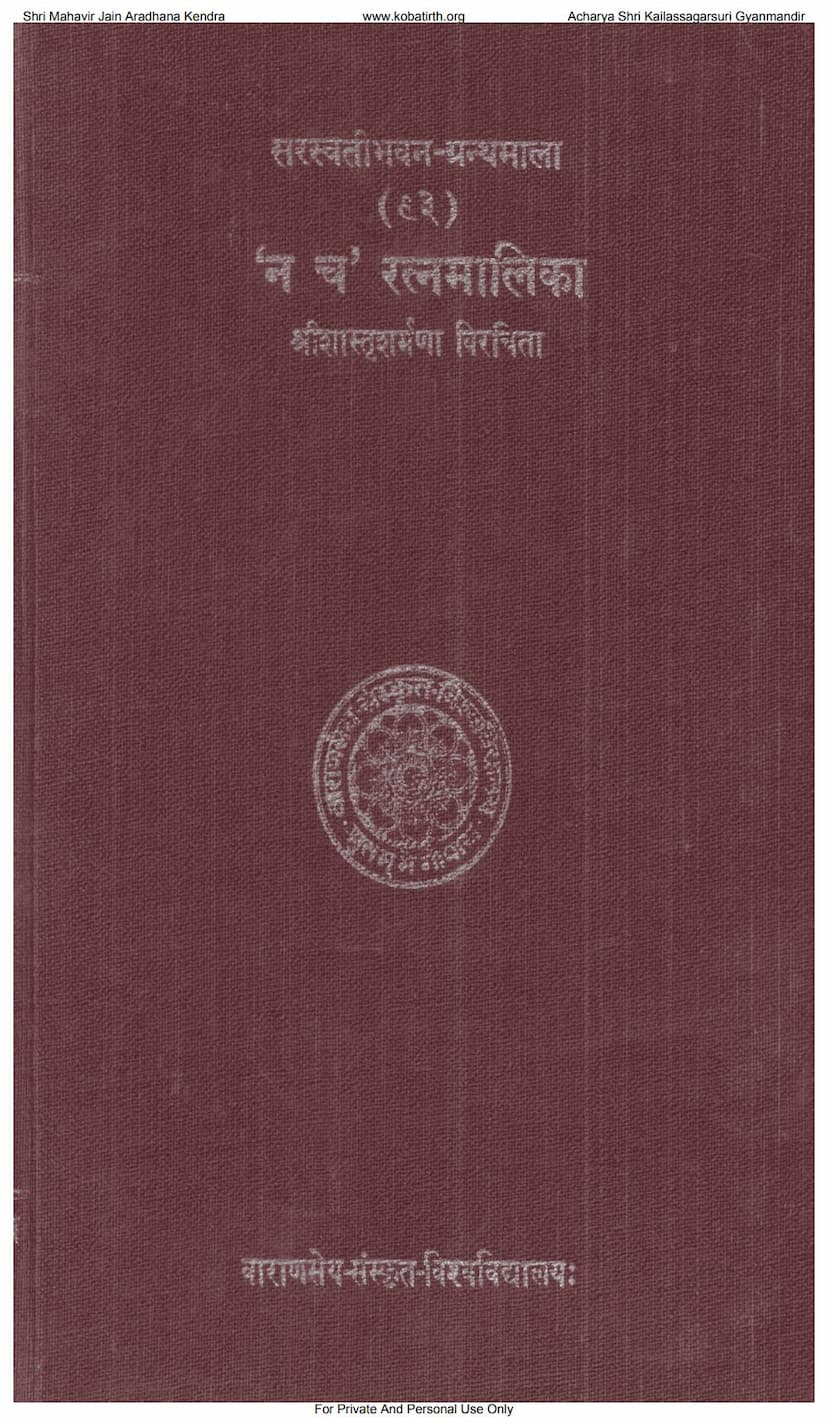Na Cha Ratnamalika
Added to library: September 2, 2025

Summary
Here's a comprehensive summary of the Jain text "Na Cha Ratnamalika" based on the provided pages:
Title: Na Cha Ratnamalika (न च रत्नमालिका) Author: Śri Śāstr̥ Śarmā (श्रीशास्तृशर्मणा) Commentary: Nūtanāloka (नूतनालोक) by the author, and Ālokaprakāśa (आलोकप्रकाश) by his disciples. Publisher: Varanaseya Sanskrit Vishvavidyalaya (वाराणसेय संस्कृत विश्वविद्यालय), Varanasi. Publication Year: 1965 (as indicated by 1887 Saka era on page 4, which translates to 1965 CE). Volume: Vol. 93 of the Sarasvatī Bhavana Granthamālā series.
Overall Purpose and Context:
The text is a significant contribution to Jain logic and epistemology, specifically focusing on the concept of vyāpti (व्याप्ति), which is a fundamental inferential relation between the hetu (reason/middle term) and the sādhya (predicate/major term) in syllogistic reasoning. The Na Cha Ratnamalika elaborates on one of the fourteen vyāpti definitions proposed by the prominent Naiyāyika logician Praśasta Pāda (referenced indirectly through "Pragalbha Niruktis" and Śrī Śāstr̥ Śarmā's work building upon that tradition). The text aims to resolve complex logical challenges and nuances within the Nyāya school of Indian philosophy, particularly concerning the definition and application of vyāpti.
Key Themes and Arguments:
-
The Nature of Vyāpti: The text delves deeply into the definition of vyāpti, particularly focusing on the second definition mentioned by Praśasta Pāda: "Yatsamānādhikaraṇasādhyābhāvapramāyāṁ sādhyavattājñānapratibandhakatvaṁ nāsti tat tvaṁ vyāptiḥ" (यत्समानाधिकरणसाध्याभावप्रमायाँ साध्यवत्ताज्ञानप्रतिबन्धकत्वं नास्ति तत्त्वं व्याप्तिः). This complex definition translates to: "Vyāpti is that which is not a cause of the ascertainment of the presence of the sādhya (major term) when there is a cognition of the absence of the sādhya that has the same locus (samānādhikaraṇa) as the hetu." The book meticulously analyzes and clarifies the various interpretations and potential pitfalls within this definition.
-
Analysis of "Yatsamānādhikaraṇa" (यत्समानाधिकरण): A significant portion of the text is dedicated to dissecting the phrase "Yatsamānādhikaraṇa". It explores its multiple potential meanings:
- That which possesses the locus of yat (यत्).
- That which has the locus which is the basis for the locus of yat.
- That which has the locus which is the basis for the locus of yat which is the basis for the locus of yat. The author meticulously examines each interpretation, pointing out logical flaws and ultimately establishing the correct understanding within the context of vyāpti.
-
Critique of Earlier Logicians and Proposals: The text engages with the views of earlier logicians like Śrī Śāstr̥ Śarmā's own guru, Mahāmahopādhyāya Bhaṭṭa Śrī Godavarma Rāja, and other renowned figures. It analyzes their definitions and refutes certain interpretations while proposing refined or alternative understandings to overcome logical inconsistencies. The author acknowledges and builds upon the work of thinkers like Saundḍa and others who addressed the issue of vyādhikaraṇa (where the defining properties are in different substrates).
-
The Role of Pramā (प्रमा - Cognition/Knowledge): The definition of vyāpti hinges on the nature of pramā. The text discusses different types of pramā, including samūhālambana (conjoined cognition) and asamuḥālambana (non-conjoined cognition), and how they impact the validity of the vyāpti definition.
-
Detailed Linguistic and Logical Analysis: The work is characterized by its rigorous analytical approach. It dissects Sanskrit grammatical structures, semantic nuances, and logical propositions with immense detail. The commentaries (Nūtanāloka and Ālokaprakāśa) further elaborate on these points, providing extensive explanations and addressing potential counterarguments.
-
Author's Background and Scholarly Context: The introductory and concluding remarks highlight the author, Śrī Śāstr̥ Śarmā, as a distinguished scholar of Nyāya philosophy, a disciple of a renowned scholar from Kerala. The publication by Varanaseya Sanskrit Vishvavidyalaya underscores its importance within academic circles of Sanskrit and Indian philosophy. The preface by Surati Narayana Mani Tripathi, the Vice-Chancellor, emphasizes the text's value for scholars and its contribution to the understanding of Navya-Nyāya (new logic).
-
Structure of the Work: The text is divided into three main sections, referred to as Āvalis (आवलि) or Prakāśas (प्रकाश) in the commentaries. Each section systematically addresses different facets of the definition and its implications. The table of contents on page 16 further outlines the specific logical arguments and concepts discussed.
Significance of the Work:
- Deep Dive into Vyāpti: "Na Cha Ratnamalika" is a specialized and in-depth study of the intricate concept of vyāpti, crucial for valid inference in Indian logic.
- Contribution to Jain Epistemology: While rooted in the broader Nyāya tradition, the work contributes to the logical framework of Jainism by engaging with and refining these core philosophical concepts.
- Scholarly Rigor: The text exemplifies the high standard of analytical and critical thinking prevalent in traditional Indian philosophical scholarship.
- Preservation and Dissemination: Its publication by a prestigious university highlights the effort to preserve and disseminate valuable traditional knowledge.
In essence, Na Cha Ratnamalika is a profound and detailed philosophical treatise on the theory of inference in Indian logic, specifically dissecting and clarifying a complex definition of vyāpti. It showcases the author's immense scholarship and the collaborative effort of his disciples and the university in presenting this work to the academic world.